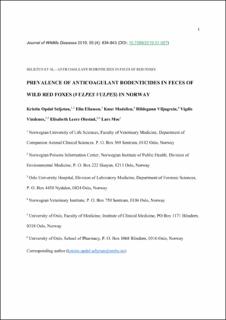Prevalence of anticoagulant rodenticides in faeces of wild red foxes (Vulpes vulpes) in Norway
Seljetun, Kristin Opdal; Eliassen, Elin; Madslien, Knut; Viljugrein, Hildegunn; Vindenes, Vigdis; Øiestad, Elisabeth Leere; Moe, Lars
Peer reviewed, Journal article
Accepted version
Permanent lenke
https://hdl.handle.net/11250/2755017Utgivelsesdato
2019Metadata
Vis full innførselSamlinger
- Artikler [5068]
- Publikasjoner fra CRIStin FHI [7544]
Sammendrag
High occurrence of anticoagulant rodenticides (ARs) in wildlife is a rising concern, with numerous reports of secondary exposure through predation. Because of widespread distribution of the red fox (Vulpes vulpes), they may act as sentinels for small mammal-hunting predators in rural, suburban, and urban areas. No AR surveillance in wild mammals with analyses of residues in feces has been conducted throughout a single country. We collected 163 fecal samples from presumed healthy red foxes from 18 out of 19 counties in Norway. The foxes were shot during regular hunting between January and December 2016 and samples collected directly after death. Fecal samples were analyzed for six ARs: brodifacoum, bromadiolone, coumatetralyl, difenacoum, difethialone, and flocoumafen. We detected ARs in 54% (75/139) of the animals. Brodifacoum was most frequently detected (46%; 64/139), followed by coumatetralyl (17%; 23/139), bromadiolone (16%; 22/139), difenacoum (5%; 7/139), difethialone (1%; 2/139), and flocoumafen (1%; 2/139). More than one substance was detected in 40% (30/75) of the positive foxes, and 7% (5/75) of these animals were exposed to four different ARs. There were no statistically significant seasonal, age, or sex differences in foxes after exposure to one AR compound. We found a significant difference in occurrence of brodifacoum and coumatetralyl in foxes from different geographical areas. These findings demonstrate fecal analyses as a valuable method of detecting AR exposure in red foxes. We suggest using direct fecal sampling with analyses as a method to evaluate the occurrence of ARs in live endangered wildlife in connection with radio tagging or collaring operations.
